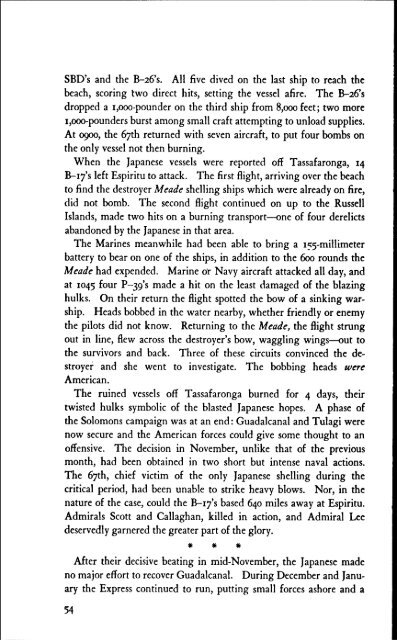Pacific Counterblow - Air Force Historical Studies Office
Pacific Counterblow - Air Force Historical Studies Office
Pacific Counterblow - Air Force Historical Studies Office
Create successful ePaper yourself
Turn your PDF publications into a flip-book with our unique Google optimized e-Paper software.
SBD's and the B-26's. All five dived on the last ship to reach the<br />
beach, scoring two direct hits, setting the vessel afire. The B-26's<br />
dropped a i,ooo-pounder on the third ship from 8,ooo feet; two more<br />
i,ooo-pounders burst among small craft attempting to unload supplies.<br />
At o9oo, the 67th returned with seven aircraft, to put four bombs on<br />
the only vessel not then burning.<br />
When the Japanese vessels were reported off Tassafaronga, 14<br />
B-17's left Espiritu to attack. The first flight, arriving over the beach<br />
to find the destroyer Meade shelling ships which were already on fire,<br />
did not bomb. The second flight continued on up to the Russell<br />
Islands, made two hits on a burning transport--one of four derelicts<br />
abandoned by the Japanese in that area.<br />
The Marines meanwhile had been able to bring a 155-millimeter<br />
battery to bear on one of the ships, in addition to the 6oo rounds the<br />
Meade had expended. Marine or Navy aircraft attacked all day, and<br />
at 1045 four P- 39's made a hit on the least damaged of the blazing<br />
hulks. On their return the flight spotted the bow of a sinking warship.<br />
Heads bobbed in the water nearby, whether friendly or enemy<br />
the pilots did not know. Returning to the Meade, the flight strung<br />
out in line, flew across the destroyer's bow, waggling wings--out to<br />
the survivors and back. Three of these circuits convinced the destroyer<br />
and she went to investigate. The bobbing heads were<br />
American.<br />
The ruined vessels off Tassafaronga burned for 4 days, their<br />
twisted hulks symbolic of the blasted Japanese hopes. A phase of<br />
the Solomons campaign was at an end: Guadalcanal and Tulagi were<br />
now secure and the American forces could give some thought to an<br />
offensive. The decision in November, unlike that of the previous<br />
month, had been obtained in two short but intense naval actions.<br />
The 6 7th, chief victim of the only Japanese shelling during the<br />
critical period, had been unable to strike heavy blows. Nor, in the<br />
nature of the case, could the B-17's based 640 miles away at Espiritu.<br />
Admirals Scott and Callaghan, killed in action, and Admiral Lee<br />
deservedly garnered the greater part of the glory.<br />
After their decisive beating in mid-November, the Japanese made<br />
no major effort to recover Guadalcanal. During December and January<br />
the Express continued to run, putting small forces ashore and a<br />
54
















